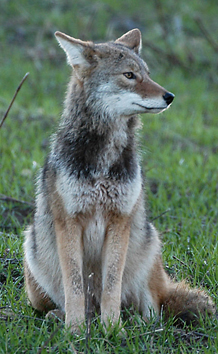
By Megan Alley
Sun staff
This time of year marks the coyote denning season, and wildlife experts are reminding county residents of some tips to avoid potential conflicts with the animal.
Some might be surprised to learn that coyotes, or Canis latrans, are common in all of Ohio’s 88 counties, in both rural and urban areas.
“I’m continually surprised at how surprised people are …. Coyotes, they are literally everywhere,” Brett Beatty, Ohio Department of Natural Resources Division of Wildlife’s District 5 wildlife management supervisor, said. “The coyote itself is a survivor; it’s a very adaptable animal.”
There are no wild wolves living in Ohio, according to the ODNR Division of Wildlife’s website.
Denning season – which runs through April and May – is the time of year when coyote pups are born (coyotes breed during the months of January and February, and they have a gestation period of about two months). During these months, coyotes look for places to dig a hole in which they can raise their young.
This is also the time when coyotes – typically a nocturnal animal – are more visible and vocal, because they’re hunting for food throughout the day, and while the wild animal usually keeps its distance from humans, they will look for food and shelter in populated areas if an opportunity arises.
Coyotes are omnivorous; their diet typically includes small mammals, such as voles, shrews, rabbits and mice, as well as vegetables, nuts and carrion, according to the ODNR Division of Wildlife’s website.
“Unchecked, they will eat livestock, particularly sheep and chickens,” states the website.
Beatty provided some tips to residents to avoid negative run-ins with coyotes:
– Don’t feed wild animals. Moreover, don’t leave food scraps outside, make sure trash is properly secured, and if you feed domestic animals outside, put their food out for a set amount of time, and then pick it up, and put it inside.
“It’ll save a lot of heartache, not just with coyotes, but raccoons, possums, you name it,” Beatty said.
– If you see a coyote, make yourself known.
“Be loud and scary, make yourself big, throw stuff, and be obnoxious,” Beatty said. “You want to continue to do that until the coyote leaves the area; if you don’t do that, then you’re reinforcing their behavior.”
He added, “So if you go out and jump around, and the coyote looks at you, and you turn around and run back into the house, the coyote considers that a win; it’s really like training a dog.”
– Keep cats in the house and dogs on leash, or under control.
– When you let your dog out at night, turn on the lights and take a look around.
Beatty also encourages people with concerns about coyotes to talk to their neighbors.
“If you live within a municipality, share your concerns with a city manager or whomever, just to bring it to their attention, so they know that there may be a coyote running about, and they can help educate other folks in the area,” he said.
While the presence of coyotes may initially raise some eyebrows, it’s important to remember that the animal provides many benefits.
“Right now, basically, they’re the top predator that we have for the most part here in Ohio … so they really serve that niche of keystone predator at this point,” Beatty said. “Some farmers actually enjoy having them on their property, because they feel they control the groundhog’s population; they’ve been known to predate on Canada goose nests and Canada geese, which can cause conflicts, so they just offer up that balance, if you will, of predator [and] prey relationship that Mother Nature is involved with.”
Beatty went on to offer up some food for thought to people who may feel anxious about the presence coyotes.
“When I’m doing coyote talks, I remind folks that coyotes are neither good nor bad; they just are. They’re just out there doing what they do, so they don’t have an evil intent in them,” he explained. “They’re not out there stalking you or anybody else; they’re just out their surviving, and being part of the environment.”
For more information on coyotes, Beatty suggests visiting the Urban Coyote Research Project’s website at https://urbancoyoteresearch.com/
